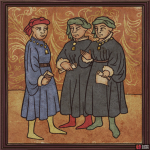Text
The nobility (nobilitas) formed the highest stratum of feudal society, possessing power and legal privileges associated with their title or family crest. They were directly subordinate to the king and held land only on loan, for which they had to pay dues to the monarch and provide military assistance in times of war. The status of a noble was hereditary, as were the land and the obligations arising from it. The land included its inhabitants, who had to pay rent and work on their lord’s fields. The oldest Czech noble families include: Buzici (e.g., Zajic von Hasenburg), Benešovici (of Dubé, of Kravař), Ronovci (lords of Lipá, lords of Dubá), and Rosenbergs. In the 14th century, the term “lord” referred only to wealthy members of the high nobility who had the right to vote for the king and sit in the provincial assembly. By the 15th century, the title “lord” was used for and addressed to not only rulers, high church officials, and nobles but also members of municipal councils and even ordinary townspeople. A zeman was a land nobleman, i.e., of local origin, living on the given land for a long time. A vladyka managed numerous estates. Squires, who formed the lower nobility, had no property of their own and served the higher nobility. The trends in art were initially influenced only by the higher nobility, but later also by the lower nobility, as they financed works of art. This included buildings, paintings, sculptures, as well as clothing accessories, hairstyles, and furniture. A nobleman did not need to be educated; it was sufficient for him to have military training. For administrative tasks and physical labour, he had his subjects and servants. His main duties included tax collection, managing military forces, and hereditary offices.


No Comments